Man and cow, an incredibly powerful bond
Host: Dr. Ross Ainsworth
A lot of my work in Asia is with small farmers who receive imported Australian Brahman cross breeders. My main focus with these farmers is helping them to understand the special differences between Australian breeders and their local cattle. The indigenous cows are a Nelore type Bos indicus that are smaller than Australian cattle but extremely fertile, able to get pregnant while lactating, and with a body condition score of 2 (out of 5) or even less. The down side is that the calves from these local cows are very small, have a low growth rate, and a final weight of not much more than 450kg for full-grown bulls. I spend a lot of my time explaining that our Brahman cattle are usually unable to get pregnant again while suckling a big calf and that weaning (permanently separating the calf from the cow) is essential in order for the cow to regain enough body condition to commence cycling again. This is where I hit my greatest snag. Nobody wants to wean but are invariably disappointed when they can’t get our Australian cows pregnant while suckling large calves. The fact is that our cattle are less fertile than indigenous cattle but in return, the Australian calves are bigger, they grow much faster, and have a significantly heavier terminal weight.
At a recent seminar in East Kalimantan, I took the opportunity to ask a large number of farmers why they refuse to wean their calves. I explained once again that they could either have a magnificent calf still on its mother or a weaned cow that could quickly get pregnant again with suitable nutrition. I also pointed out how much it was costing to continue to feed the empty, lactating cow while they could reduce their feed bill by simply weaning their huge calf. The answer was unanimous. “We like to look at our magnificent calf (and show it to their friends) and we don’t care if it costs a lot to keep feeding the empty cow for an extended period”. Its is like having the national champion calf in your back yard and being asked to cut back on its nutrition in order to save a small amount of money. Forget it!
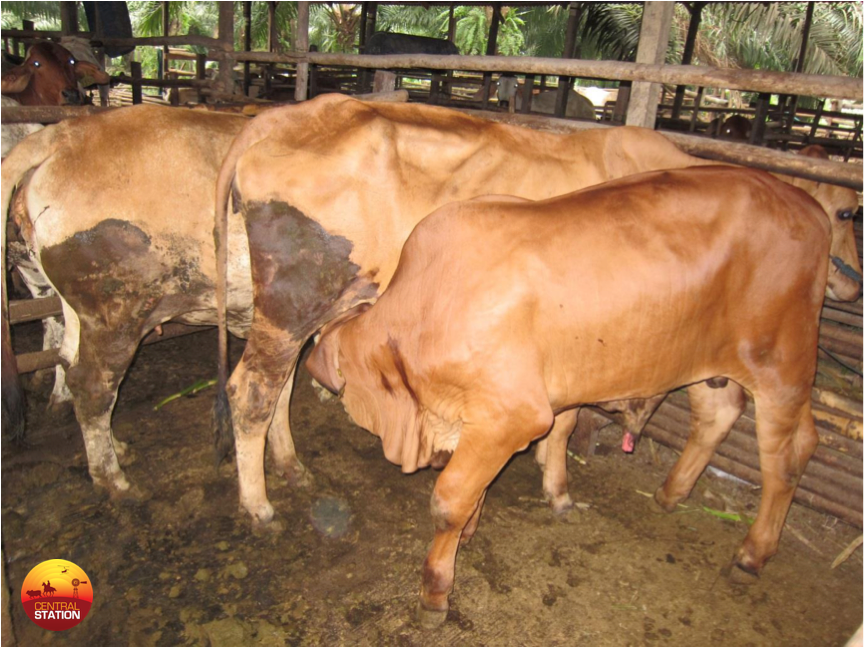
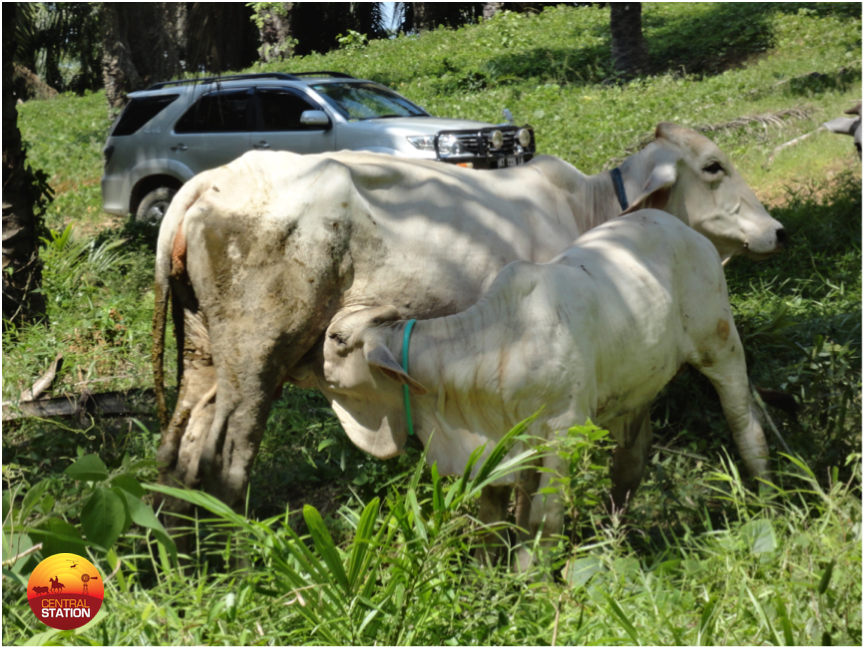 Calves from Indonesian cows never, ever look this good.
Calves from Indonesian cows never, ever look this good.
This non-commercial infatuation with cattle, especially outstanding specimens, doesn’t just relate to beautiful weaners, with many farmers refusing to sell their cattle even when they grow up. When I asked Pak Rida from East Kalimantan (photo below), when and how he intended to sell his young bull (21 months), he looked at me as if I had said something very rude or inappropriate to him. He politely explained that to sell this calf would be equivalent to selling one of his children. End of discussion.
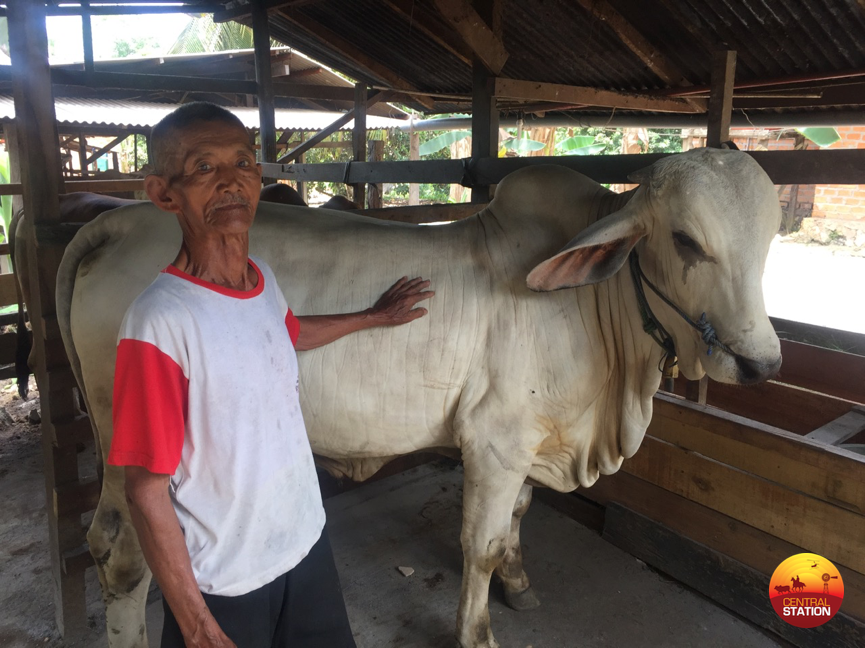 Pak Rida and his bull calf.
Pak Rida and his bull calf.
The farmer in the next photo is Pak Giwo from Lampung in South Sumatera. He works incredibly hard climbing about 50 coconut trees twice a day to collect juice from the flowers at the top of the tree to produce palm sugar. He puts a large proportion of his remaining time and hard won cash into his two beloved cows (ex-Australia) and their progeny. He spends as much of his day as he can in the pen with his cattle, caring for them and feeding them special treats. He does occasionally sell one of the offspring but with great sadness and only in circumstances of extreme need. Weaning is also a no-go area for him, as he likes to see his calves grow fast and fat and shinny. Never mind the consequences of an empty mother. To watch his exceptional calf grow up quickly is more than enough reward for him.
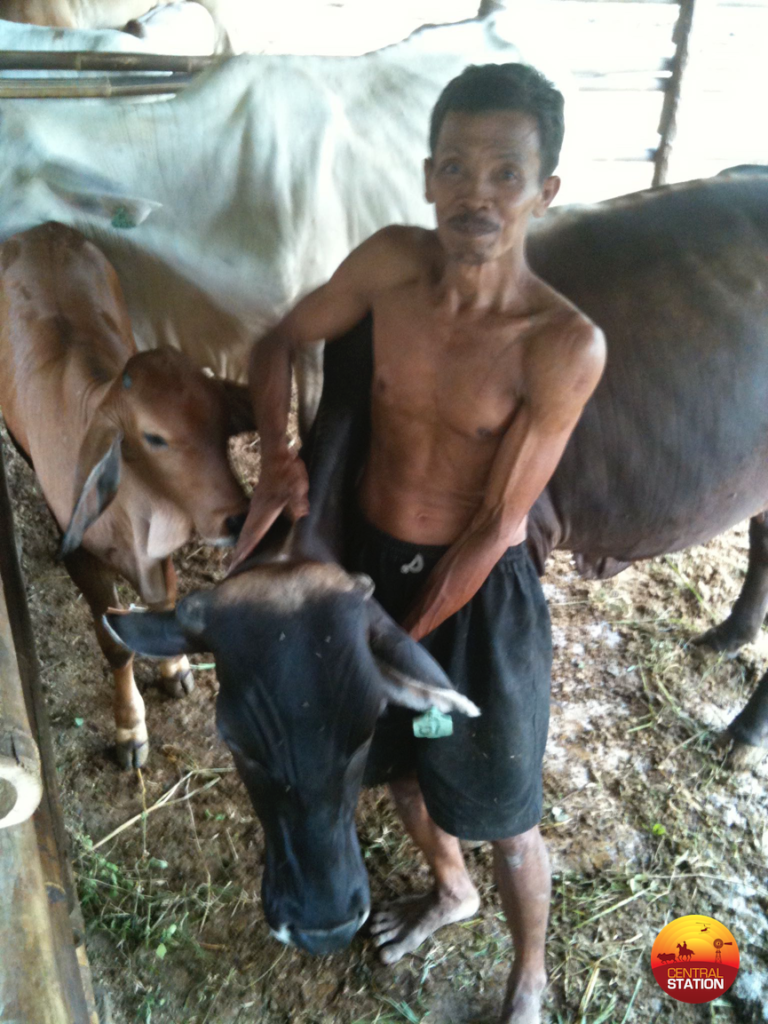 Pak Giwo with his cows and calf.
Pak Giwo with his cows and calf.
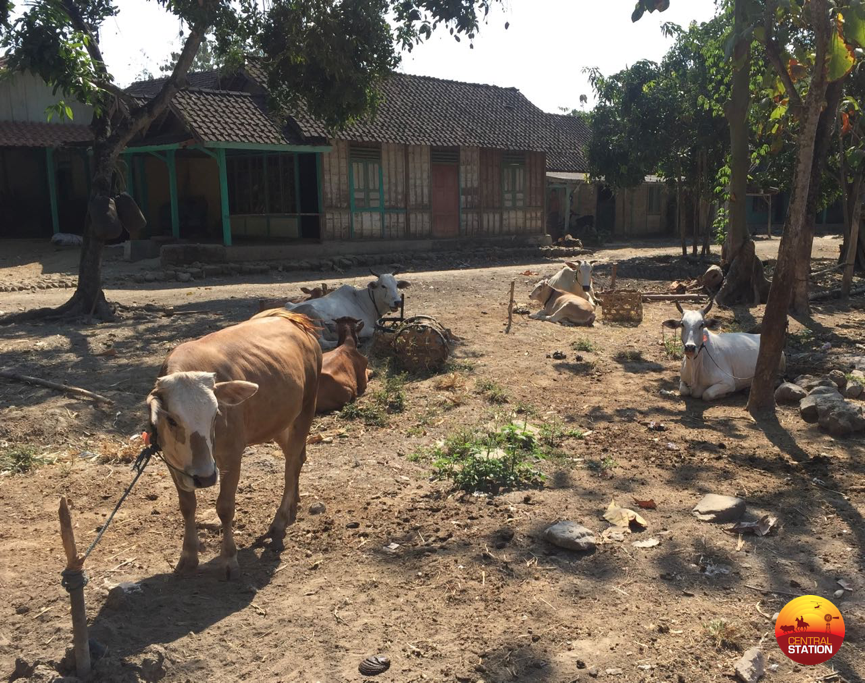
Farmers across Indonesia proudly show off their cattle whenever they can. The cattle below are in a village in East Java where the owners bring them out from their overnight pens behind the house to tether them in front of their home for an hour or so in the morning before walking them out to graze during the day. This display of cattle in front of the house is the equivalent of your Australian neighbour parking his new Mercedes car in the driveway to show everyone in the street how rich and successful he is. In this case however the cattle in the photo will be collectively worth much more than the owner’s house.
During my discussions with farmers I have occasionally been unwise enough to observe that in terms of return on investment and ease of management, goat production would be a far more profitable enterprise than feeding cattle. On all occasions I get the same response. In short, cattle provide the farmer with the highest social status of any form of agricultural production and as long as it is humanly possible, farmers will retain their cattle, and enjoy the social status that they provide, without regard to secondary financial considerations.
On reflection, Australian cattle producers very often demonstrate a similar passion towards the ownership of cattle, which has nothing at all to do with income. Up until very recently, the return on investment from beef cattle enterprises has been pretty dreadful with returns averaging less than 5% per annum for the last 40 years. Throughout that entire time they could have sold their cattle production asset and achieved a much greater return through buying a block of flats in Sydney or almost any other form of investment of their capital. Just like the small farmers in Indonesia, cattle people in Australia, and I suspect elsewhere around the world just love working with cattle and the lifestyle that this industry provides. While it is easy to recognise, I am unable to explain the origins of this extraordinary bond that some humans can develop with cattle. It is however very real and plays a large part in cattle owner’s decision-making processes. It is certainly an equally powerful consideration to financial returns. Swap the farm for a high yielding block of flats? Absurd. And I definitely wouldn’t be reckless enough to suggest that they would be financially better off by switching their investment to goat production.
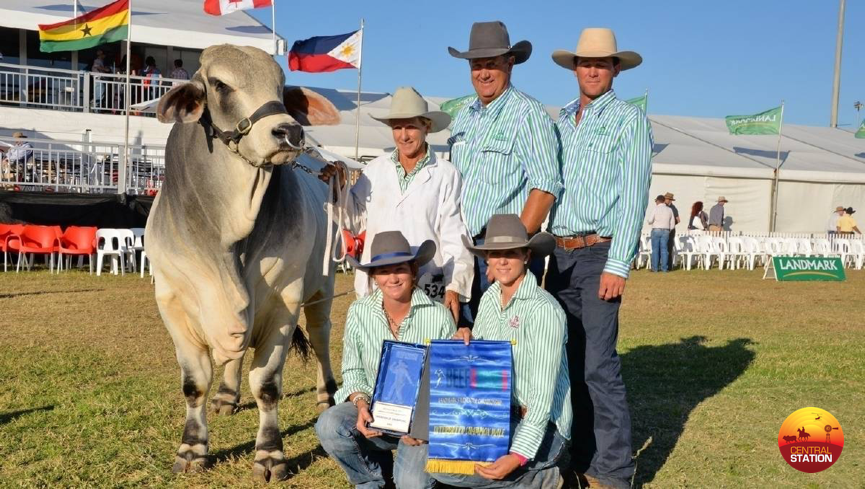 Andrew Olive and family with their champion bull at Rockhampton 2015. Swap their cattle business for a block of flats with a larger return? I don’t think so.
Andrew Olive and family with their champion bull at Rockhampton 2015. Swap their cattle business for a block of flats with a larger return? I don’t think so.
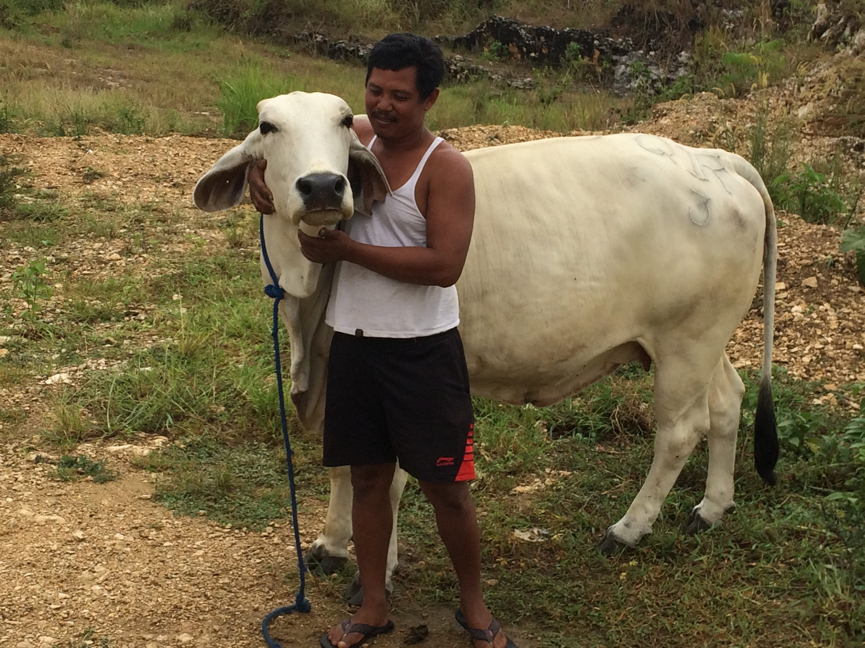 East Kalimantan farmer Pak Lyon with the mother of the calf below. She was imported from Queensland as a pregnant heifer in November 2015.
East Kalimantan farmer Pak Lyon with the mother of the calf below. She was imported from Queensland as a pregnant heifer in November 2015.
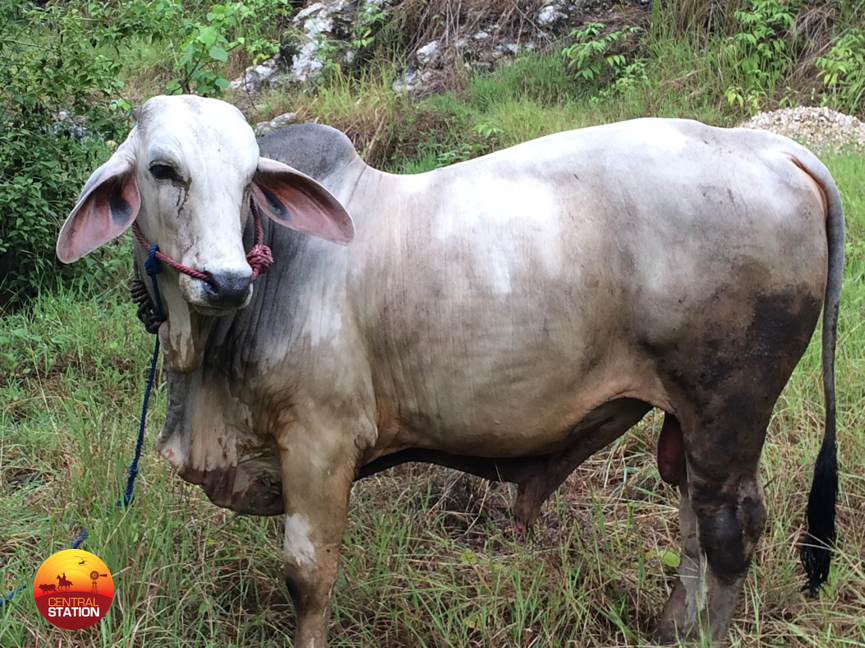 This young bull’s name is Jombul. He is about 22 months old and close to 500kg. And not for sale under any circumstances! Now I understand.
This young bull’s name is Jombul. He is about 22 months old and close to 500kg. And not for sale under any circumstances! Now I understand.
